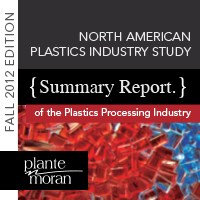Requirements for Success
The Fall 2012 edition of the North American Plastics Industry Study Summary Report from Jeff Mengel and Ted Morgan of Plante Moran is available. This report summarizes data from 135 completed surveys collected through September 2012, representing more than 220 facilities in a broad array of processes from throughout North America. Here they summarize some requirements for success based on their findings.

The Fall 2012 edition of the North American Plastics Industry Study Summary Report from Jeff Mengel and Ted Morgan of Plante Moran is available. This report summarizes data from 135 completed surveys collected through September 2012, representing more than 220 facilities in a broad array of processes from throughout North America. Here they summarize some requirements for success based on their findings:
Flexibility is required to address the vagaries of manufacturing. Whether it is managing material fluctuation, skill availability, or the effects of tsunamis from halfway around the world, you need the ability to manage the unknown. Perhaps that is one reason this industry is so fragmented with small companies. An efficient organizational structure with fewer levels is the best method to embrace change and reduce risk.
Currently, companies are as efficient as they have ever been due to the cutbacks of the recession. The conundrum is the need for sales growth while retaining your efficiency. Figure that one out and you are a winner.Growth is required for enhancements to enterprise value. Profitability without growth is a slow death. Eventually, your skills that create the profits will commoditize and you will lose your profitability as well as growth. However, growth is also chaotic as well as exciting. Uncontrolled growth leads to bloated indirect staff who are only temporarily necessary, but often become permanent. Companies with controlled growth were normally the most profitable. Still, our highly successful companies averaged 20% growth to prove you can have your cake and eat it too.
Skills or locations – must have one and both are at risk. Customers are moving away; competitors are moving in or competing from afar, and a commoditization of skills/products is reducing your competitive advantage. You need to re-invent yourself on a periodic basis. Too many companies still think they compete with customer intimacy, only to discover it was customer convenience. One of the problems with raising resin prices is you will test your customer’s patience if you are only convenient versus intimate. Intimacy requires you to be designed to meet the specific needs of your customer to make them better off — where replacing you is more than inconvenient.
Competing on technical skills requires you to differentiate — ergo my issue with circa 1980 technology. Old presses may still work, but they should be wrapped in several layers of technology — whether in the mold, secondary operations, or unique (including multi) materials. Continued productivity improvements – the industry has been able to process more material with fewer and fewer personnel ever since we have studied the industry. As the economy has globalized, the domestic processors have had to innovate to compete at a global level. We do not see that trend abating as our global competitors are getting better
each year.
We classify any company that exceeds a 10% return on sales (before interest, taxes, and owners compensation), a return on assets in excess of 15%, and sales growth greater than 5% as a successful company. Highly successful companies did not earn their profitability through higher utilization, but rather through higher complexity and quality. During the recession, higher complexity limited customer concentration and reduced risk. The product had exceptionally low quality issues, both from the customers’ perspective as well as within the molding operations. Highly successful companies have very strong balance sheets that support a high sales growth.
These companies are rare – fewer than 10% of the participants meet these criteria. However, these companies serve as a beacon of hope that a well-designed company can be highly successful in a very competitive market. The following graphs show how the average company by sales quartile compares to the successful company.
Full summary here.
Read Next
Reasons to Use Fiber Lasers for Mold Cleaning
Fiber lasers offer a simplicity, speed, control and portability, minimizing mold cleaning risks.
Read MoreHow to Use Strategic Planning Tools, Data to Manage the Human Side of Business
Q&A with Marion Wells, MMT EAB member and founder of Human Asset Management.
Read MoreAre You a Moldmaker Considering 3D Printing? Consider the 3D Printing Workshop at NPE2024
Presentations will cover 3D printing for mold tooling, material innovation, product development, bridge production and full-scale, high-volume additive manufacturing.
Read More
















